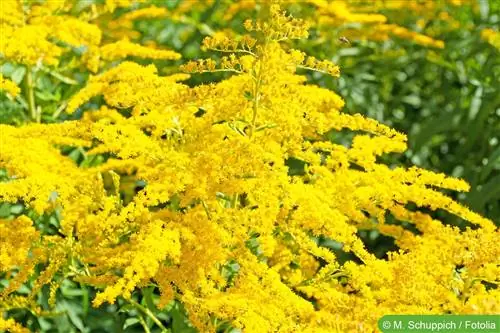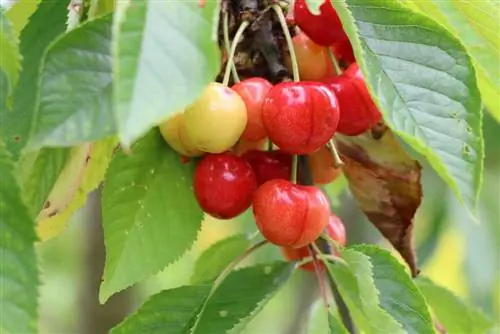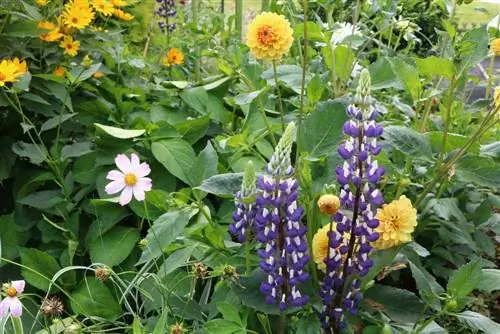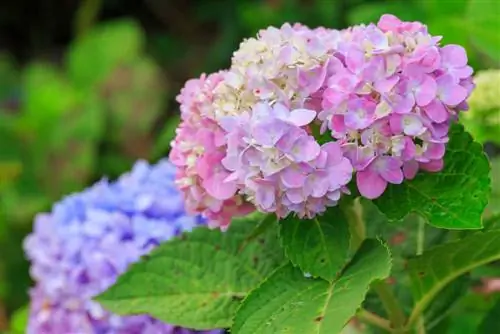- Author admin [email protected].
- Public 2023-12-17 03:39.
- Last modified 2025-06-01 06:48.
The plant genus goldenrods or goldenrod (Solidago) is a robust perennial that thrives even with inexperienced gardeners. In addition to several wild species, there are also numerous cultivated species of the undemanding goldenrod, which differ primarily in size. This means that the Solidago plant genus can be used in a variety of ways in the garden and, depending on the species, thrives both in the shade and in sunny places. It harmonizes very well with other perennials and sets beautiful accents in a perennial bed thanks to its golden yellow color.
Profile
- Name: Goldenrod (Solidago)
- Family: Daisy family (Asteraceae)
- Growth habit: paniculate, upright branches; lanceolate, toothed leaves
- Growth height: 20 - 200 cm
- Flower color: yellow
- Flowering time: July - October
- Location: sun or partial shade
- Hardy: yes
Location
Tall-growing species are suitable as solitary plants, while low-growing species can easily be combined with other perennials. The common goldenrod, like other Solidago species, is very undemanding when it comes to its location. It can also stand in the shade or partial shade and is suitable, for example, in the garden for shady locations that need to be brightened up with a light flowering color. Cultivated forms or the Canadian goldenrod, on the other hand, prefer very sunny locations. They also have somewhat higher demands in terms of nutrient requirements and must be supplied with sufficient water. The soil should be loamy to sandy, as the Canadian goldenrod, for example, prefers to inhabit rubble areas or moist or loamy ditches in nature.
Tip:
The goldenrod should also be planted in a pot in a perennial bed, otherwise it will spread too quickly and possibly crowd out other perennials.
Care
Fertilize
Basically very undemanding. They can survive without many nutrients for a long time, but to ensure good growth in the garden they should be occasionally supplied with fertilizer. The ideal time to fertilize is spring, when the perennial is supplied with organic fertilizer such as compost, guano or horn shavings. Work fertilizer lightly into the surface and then water regularly and abundantly so that the nutrients reach the soil.
Tip:
If the goldenrod is in the same bed with other perennials, it does not need to be fertilized directly; the remaining nutrients when fertilizing the surrounding perennials are usually sufficient.
Wintering
Goldenrods are frost-resistant down to -30 °C and do not need special protection in winter.
pruning
Pruning is carried out immediately after flowering, which means there is a chance that it will bloom profusely again in the autumn after an early flowering in the summer. If self-sowing is not desired, the perennial should definitely be cut back after each flowering.
Tip:
The goldenrod looks good in autumn and winter, even when it has faded. In a natural garden, pruning before winter is therefore not necessary and, for example, hoar frost can form on it or serve as a landing place for birds.
Propagation
Once planted in the garden, the goldenrod is a permanent guest that also likes to spread through self-sowing. If it is cut regularly after flowering, it can also be propagated by division. To do this, the perennial is carefully divided with a spade in the spring, which also rejuvenates it.
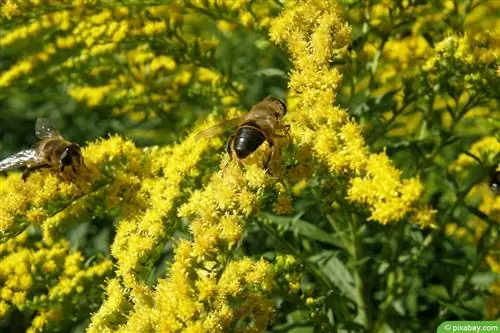
Diseases
In general, goldenrod is not susceptible to any specific diseases. Longer dry periods can cause problems for goldenrod and mildew can form on the plant. In this case, only the affected parts of the plant need to be cut off and disposed of in the residual waste, as the fungus cannot spread to other plants through the compost. The goldenrod usually survives an infestation of powdery mildew without major damage. Only if growth problems occur or there is a high risk that other plants could also be affected, a pesticide should be used.
Tip:
The goldenrod can also react with growth disorders due to over-fertilization. If in doubt, you should simply stop fertilizing until next year, as the plant usually regenerates itself without any problems.
Varieties (selection)
- Solidago virgaurea: The native wild form of goldenrod is Solidago virgaurea, which is mainly found along forest edges. In nature, the common goldenrod is very inconspicuous because the soil often does not provide enough nutrients for it to produce beautiful, large flowers. The common goldenrod has a branched but very upright habit and few basket flowers. However, in the garden under good conditions it is much more flowery and also produces beautiful, large flowers.
- Canadian goldenrod: The Canadian goldenrod is particularly visually appealing and can reach heights of up to 2.50 m. Although it has significantly smaller flowers than the common goldenrod, it has many more that stand out for their abundance.
- Goldenmosa: The various cultivated forms also have very pretty flowers, such as the Goldenmosa, which has golden-yellow mimosa-like flowers. The radiant crown cultivar is comparable to the Canadian goldenrod, but with growth heights of up to 60 cm. Similar to its wild relative, it produces flat flower panicles in the upper part.
- ‘Solidago x Solidaster luteus’: Well-known cross between Solidago and Aster ptarmicoides. It impresses with daisy-like flowers in bright yellow that sit in dense clusters. It is ideal for bouquets.
- Goldenmosa: the variety got its name from its very pretty mimosa-like golden yellow flowers
- Golden Thumb: height 20 cm, very low, rather delicate variety with golden yellow flowers
- Ledsham: height 80 cm, flowers in light yellow
- Late gold: height 60 cm, as the name suggests, late-flowering variety with yellow flowers
- Radiant crown: height 60 cm, particularly striking due to its flat flower panicles in golden yellow
- Tara: flowers enchant with their bright, sunny yellow
Frequently asked questions
Can goldenrod also be planted in a pot?
Goldenrod is also suitable for cultivation in pots. The substrate should be permeable and have a high proportion of sand. The pot can have a layer of gravel or coarse stone as drainage. When cultivating in a pot, however, it is important that the goldenrod is fertilized and watered regularly. It also needs to be protected from frost in winter so that the roots are not damaged. However, it is sufficient if the pot is simply buried around two thirds in an empty bed. Since the goldenrod grows quickly, it should be given a pot all to itself. It also needs to be repotted regularly if the container becomes too small, or needs to be divided and distributed across several pots.
Is it better to buy goldenrod as a perennial or to sow it?
Specialist retailers already have a large selection of goldenrod species at very reasonable prices. If you want to fill a herbaceous bed with attractive perennials, one plant is enough, because goldenrod grows very quickly and can be divided again and again in the following years. To plant larger areas with goldenrod, the plant is not cut, so it propagates by self-seeding.
Is goldenrod suitable as a cut flower?
The goldenrod not only cuts a fine figure in the bed, but also in the vase. However, the cut should be made as far down as possible; the stem can then be shortened later for the vase. This means there are no unsightly residues left and the perennial is motivated to produce new shoots. In addition, only inflorescences that have recently bloomed or are about to bloom should be used for the vase. Older inflorescences, on the other hand, wither very quickly in the vase and tend to leave their seeds on the table.
What you should know about goldenrod in brief
- Species/Family: Wildflower perennial, belongs to the daisy family (Asteraceae)
- Care effort: low, easy to care for
- Flowering period: July to September/October with loose, feathery and slightly curved panicles consisting of a large number of very small star-shaped individual flowers
- Foliage: oil-elongated, lanceolate leaves in fresh green that are clearly veined
- Growth: strong growing, upright bushy and clump-like growth, does not proliferate
- Height/width: depending on the variety, 20 to 150 cm high and 25 to 60 cm wide
- Location: sunny, tolerates partial shade, normal garden soil is sufficient, should not be too nutrient-rich and too dry
- Planting time: always, as long as the ground is not frozen
- Cutting: immediately after flowering, if self-sowing is not desired as it collects quickly
- Partners: fine jet, grasses, autumn aster, delphinium, scabiosis, sun bride
- Propagation: Division in spring (division also rejuvenates the plant and keeps it blooming over the years), sows itself abundantly, seeds can also be collected
- Care: water when dry, do not fertilize
- Wintering: hardy
- Illnesses/problems: weakens with too many nutrients, so do not fertilize
Special features
- also available as garden goldenrod
- We mostly offer breeds, with the parent species coming from North America
- fits perfectly into the wildflower garden and the natural garden
- very good and durable cut flower
Tip:
Since goldenrod likes to sow itself abundantly, this should be prevented by promptly removing the faded flower stalks if it is undesirable. Insects love this late summer source of nectar.

